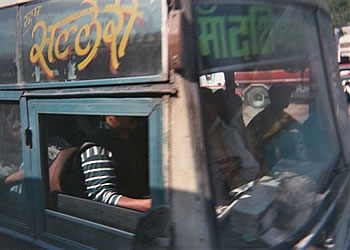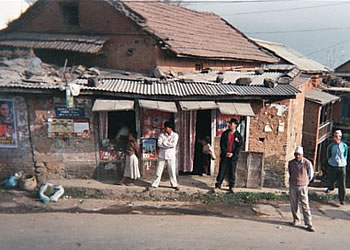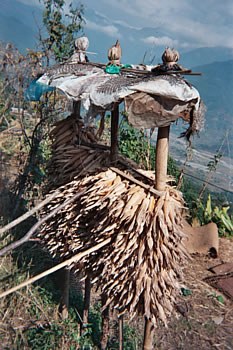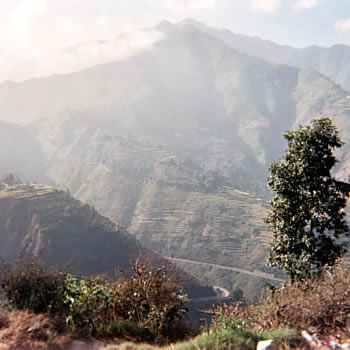| |
Thursday,
November 13
Kathmandu Valley
The
morning of Friday, November 13, we took a tourist bus (Rob
thought it would be safer) from Kathmandu to Pohkara, where
lives the family Rob came to visit, and from whence the trek
would be staged. The bus was far from full, so I got to move
around from side to side depending on where the best view
was found. It was a fascinating ride all the way. (I always
like bus rides because there is no stressful interaction or
decision making; just sitting back and taking in the country.)
Glimpses of Nepal waking as we left Kathmandu. One image to
me summarizes all that we saw along the road: there was a
sprawling morning glory vine that was coated dirty white with
dust from the road. But the beautiful purple blossoms had
just opened and were spectacular and immaculate. Like the
people who live along the road, the women emerging from their
dusty huts in immaculate brightly coloured sarees, the children's
white shirts spotless as they walk to school wearing their
school uniforms.
Along the outskirts of Kathmandu,
the highway is lined with shops, and people out, kids going
to school, people starting their day, shops opening.
There were quite a few army
checkpoints along the way, due to the Maoist rebels' activity,
which slowed us in that there were sometimes lines of vehicles
waiting to pass through. But they never delayed us at the
checkpoint when they saw that tourists were involved.
We climbed out of the Kathmandu
valley up over a ridge, and on the other side was a winding
road along a deep river gorge that we would follow the rest
of the journey. It being the dry season, the river was small.
But in the rainy season this road is often impassable because
of rock slides and washouts. We saw the evidence of this,
and felt it on rough patches of pavement. There was a large
boulder on the road, and a place where a bridge had been washed
out.

The driving style in Nepal
is scary to the uninitiated. The bus would pass on blind curves
and hills, horn blaring. You could just imagine another bus
coming the opposite direction careening over the hill and
the resulting crash. And yes, we did see the hulking wreckage
of such a head-on collision between two busses. And we later
met a guy who had seen four such on this same road.
The countryside was beautiful,
with mountainsides terraced far up in elevation, and houses
visible on the steep slopes high above the road. People worked
above us as we passed, children stood on the edges of terraced
fields looking down at us. And because the mountain was steep
up on one side of the road and the river gorge steep down
on the other, the road was the sidewalk for children in their
spotless uniforms walking to and from school, and for other
pedestrians as well. Little houses lined the sides of the
road, some of them made of stones, which are plentiful. The
houses shared public water sources that were spaced along
each side of the road. These consisted of a horizontal concrete
slab and at the back of it, a vertical slab (wall) with a
faucet emerging from it. People bathed at these faucets, minimally
clothed. One young woman wore a thin simple dress and washed
completely in what must have been very cold water, there in
public view. But then, there is a different standard of privacy.
They washed dishes there in plastic dishpans, and they collected
jugs of water to take back to the houses for cooking. The
stoves were simple clay boxes with one end open, where small
logs with one end burning were inserted. The upper surface
of the stove was thus heated and pans could be placed there
for cooking. The forests are dense and the supply of wood
seemingly more than sufficient. Some houses had outhouses.

The houses had a room or two
enclosed, but a lot of living took place outside, right beside
the road. The stove was outside usually, and people would
squat there by the road to gather and talk or work. Many people
were employed in making gravel from stones that were collected
from the riverbed, this being the dry season. Trucks found
their way down to the riverbed and were filled with stones.
People could be seen with hammers reducing stones to gravel,
presumably for the making of concrete. It obviously is a very
hard life, and these families had very little by comparison
with most in our country, but smiles were not in short supply.
For lunch this day, we stopped
at an upscale resort by the side of the road. We had a buffet
lunch at outside tables, surrounded by manicured gardens bright
with flowers. And many species of butterflies deftly worked
the nectar factories. Butterflies for lunch.
Wherever there was flat soil,
people were farming. There was a lot of grain harvesting going
on, which I think may have been millet, but I am not sure.
Women do a lot of heavy physical work in Nepal, and this includes
farming. They could be seen in the fields, wearing their bright
red sarees with gold trim, cutting the brown stalks of grain.
The stalks were spread out to dry. They threshed the grain
by gathering a bunch and striking the heads repeatedly on
a tarp. Some men were threshing with oxen, driving the oxen
in a circle, walking over the harvest. Once the grain was
separated, the dried stalks were piled in stacks for animal
food. And the grain was dried in the sun and winnowed.

Others were busy
planting what looked like rice. It is very manual farming,
with not a tractor anywhere. I did see some men plowing with
teams of oxen, both in fields along the road and later on
the trek.
Closer to Pokhara, the land
was flatter and there were bigger farms and bigger houses,
many of which had a hallway straight through the center of
the house, with doors on each end that were grillwork only.
As we drove into the outskirts
of Pokhara, long before we reached the tourist section beside
the lake, there was a little carnival with a small Ferris
wheel. "It's the Pokhara Eye," I said, but really
the Pokhara Eye was a stupa on a mountain top across the lake,
which we would visit the next day.
- - - - - - - -
The bus stopped in a small
field (or vacant lot) near the tourist section of Pokhara.
We grabbed our bags, and I was reminded of how heavy my pack
was. Ignoring the taxi drivers, we walked up the sidewalk
by the road along the lake, turning down a side street to
arrive at the Hotel Nirvana. My large, comfortable room was
on the end on the second floor, with windows on 3 sides.
The
next day
this
travelogue is part of the subside
travelzine
about bookshelf
links contact
submit
|
|



